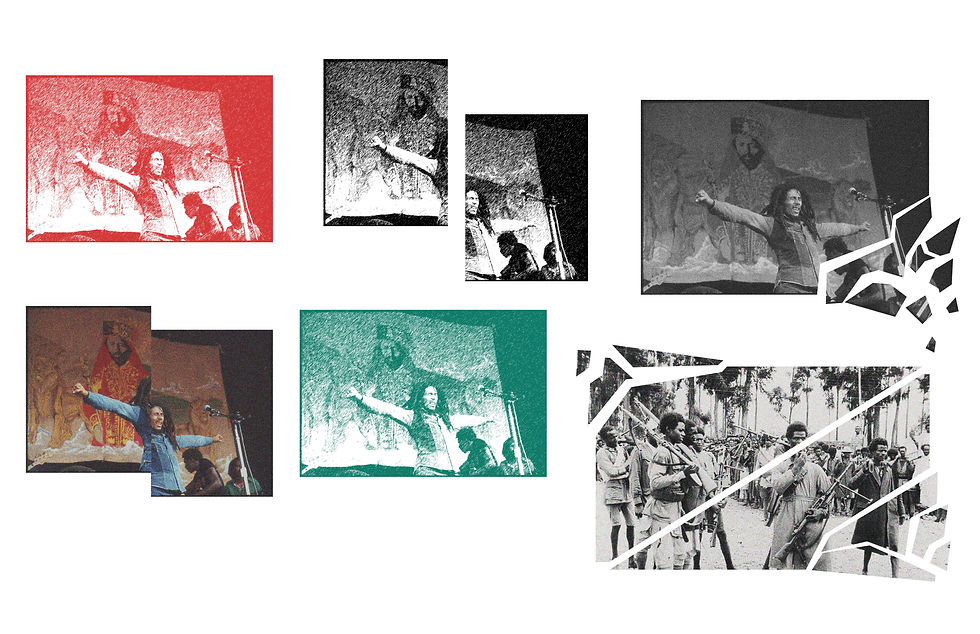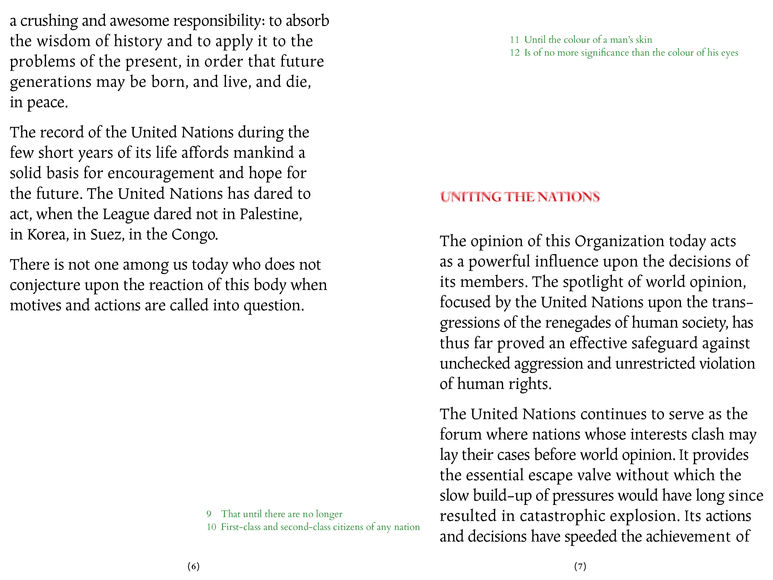RISE UP
A book intersecting Haile Selassie's speech to the United Nations in 1963 with Bob Marley's lyrics of War and other selected songs. Rise Up combines visual themes of religious texts and manipulation of found imagery to weave together the voices and tell the narrative of protest and unity.






PRESS FOR FULL SCREEN GALLERY
PROCESS
RESEARCH
I was drawn to the relationship between Haile Selassie and Bob Marley because of the many themes that brings them together. Because of the religous connection of Rastafarianism, the rhetoric they used in their speeches and songs respectively often intersected. Early on, I was interested in finding visual sources that showed the various languages of music, protest, and hope.




The language of this first concept ended up being the most consistent with how I grew to talk about the book. This concept was much more focused on the idea of things coming together, how Bob Marley and Selassie were icons of unity, freedom, and community.
CONCEPT DEVELOPMENT
I found myself being really attracted to images of Selassie and Marley because of the presence they had as figures and what they really represented as icons.
Meanwhile, I was also thinking about how these two texts can really intertwine within the design, sharing space and playing off each other’s language.


The second concept was much darker. Of course, the plea for unity and freedom from both figures and texts comes out of an ongoing conflict of colonialism, war, and violence. This concept was playing up the harsh realities that made the need for figures like Selassie and Marley as peacemakers. I was aware that this concept would lead to a visual language that was more comofortable for me so I was skeptical of getting too attached to this. I wanted to challenge myself for this book to choose a conceptual direction that pushed me to slightly unfamiliar visual languages.
TYPE CHOICES





Finding type foundries from Jamaica or Ethiopia was very difficult. So, I leaned heavily on my conceptual base of religion as a entry point into my type choices. Whether it was type like Study that had religious text feelings with interesting inflections or more anonymous serif fonts like Cardo, I wanted to find something that would have nods towards Amharic script and also embody the iconiclism of Marley and Selassie as characters.
I explored a wide array of what the images could communicate in relation to the themes I was choosing. There was something religious and introspective about the dissociation from the body. The splits and merging images had the potential to grow and adapt over the course of a book. Using the same powerful image of Marley and Selassie for these studies also meant I could see what the effect does to such a powerful image and really study the effectiveness of the image manipulation.
IMAGE STUDIES



I explored a wide array of what the images could communicate in relation to the themes I was choosing. There was something religious and introspective about the dissociation from the body. The splits and merging images had the potential to grow and adapt over the course of a book. Using the same powerful image of Marley and Selassie for these studies also meant I could see what the effect does to such a powerful image and really study the effectiveness of the image manipulation.
IMAGE STUDIES
TESTING THE CONCEPTS




Both concepts played into the large dominate type to give Selassie a real voice. Concept 1 also experimented with verse numbers, something that would come into the final concept. Otherwise, the differences came in the image treatment and color, both things that generated a certain tone and feeling.
CONCEPT 1
CONCEPT 2
The book map started to show how the system can play out over the course of the text and I started to think about how I could express spreads of pause, intensity, or climax. Those are the important moments I iterated on the most.
MAPPING CONCEPT


The book map started to show how the system can play out over the course of the text and I started to think about how I could express spreads of pause, intensity, or climax. Those are the important moments I iterated on the most.
MAPPING CONCEPT
COVERS
The covers were a chance to bring in the visual langauge of the book and also include an arresting image that displayed the relationship of the two voices. While they all showed a similar affect, I was playing around with how the image could be different and change the impression and composition from front to back cover. The prominence of the type was something I was playing with too. Here I also realized how the type could be manipulated in a way that fit the system, something I then used in the book itself.




COVERS
The covers were a chance to bring in the visual langauge of the book and also include an arresting image that displayed the relationship of the two voices. While they all showed a similar affect, I was playing around with how the image could be different and change the impression and composition from front to back cover. The prominence of the type was something I was playing with too. Here I also realized how the type could be manipulated in a way that fit the system, something I then used in the book itself.
STRETCHING THE SYSTEM
Once the system gained more clarity, there was more room for nuanced complexity. Things like effects on the type, scale, background shifts and climaxes all created more dynamic pacing.




BINDING
Since my book had plenty of spreads that used the gutter space, I knew I wanted to bind accordian or drumleaf. I wanted the book to have a biblical presence, playing into visual themes within the book and the size of the book. Drumleaf made the most sense since there wasn’t a reason to sacrifice structural integrity for an accordian book, it didn’t make sense for my concept. The hardcover was a no brainer, adding a presence in the hand and on the table. I ended up only binding to the back cover so the book could lay more flat.


























